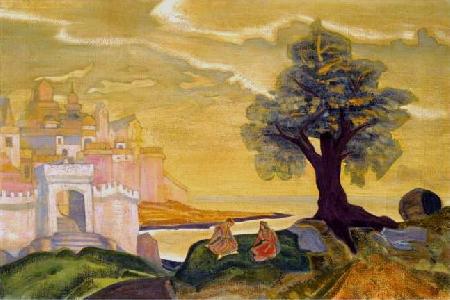 >>
>>
| Картины Н.К.Рериха |
<<  >> >>
| сменить фон |
Ссылка на изображение: http://gallery.facets.ru/pic.php?id=1677&size=3
| |
|
|
||||||||||||
|
||||||||||||
|
||||||||||||
Important Russian Art Sale: L10111 | Location: London Auction Dates: Session 1: Mon, 07 Jun 10 7:00 PM LOT 15
PROPERTY FROM A PRIVATE COLLECTION, USA - NIKOLAI KONSTANTINOVICH ROERICH 1874-1947
LEDENETS TOWN, SET DESIGN FOR RIMSKY-KORSAKOV'S OPERA THE TALE OF TSAR SALTAN, 1919 500,000—700,000 GBP Lot Sold. Hammer Price with Buyer's Premium: 601,250 GBP measurements 61 by 91cm, 24 by 35 3/4 in. Description signed with artist's monogram and dated 1919 l.r.; further inscribed on the stretcher N 13. (19). L. tempera and oil on canvas
PROVENANCE Acquired directly from the artist on the 4 October 1921 Thence by descent
EXHIBITED The Goupil Gallery, London, Nicolas Roerich, Spells of Russia, April-July, 1920 The Public Art Gallery, Worthing, Nicolas Roerich. Spells of Russia, July–August, 1920 Kingor Galleries, New York; Boston Art Club, Boston; Albright Art Gallery, Buffalo; Art Institute, Chicago; City Art Museum, St Louis; Museum of Art, San Francisco, The Nicholas Roerich Exhibition, 1920–1921
LITERATURE AND REFERENCES Nicolas Roerich, Spells of Russia: Catalogue, The Goupil Gallery, 1920, No. 144 Nicolas Roerich, Spells of Russia: Catalogue, The Public Art Gallery, Worthing, 1920, No.67 or 134 C. Brinton, The Nicholas Roerich Exhibition, New York, 1921, No.90 Nicolas Roerich Exhibition: Catalogue, San Francisco Museum of Art, 1921, No.90 F. Grant et al. Roerich, Himalaya, A Monograph, New York: Brentano's Publishers, 1926. p.197 List of Nicholas Roerich Paintings, 1917–1924, Autograph, Nicholas Roerich Museum Archive, No. 13, 1919
CATALOGUE NOTE In 1919, Roerich travelled to London to work on set designs for the Royal Opera House. The offered lot is a design for Rimsky-Korsakov's opera The Tale of Tsar Saltan, for which Roerich made about a dozen large décors, numerous smaller sketches and costume designs, although the production itself was never realised on stage.
Composed in 1899-1900, the opera is based on the poem of the same name by Alexander Pushkin. In Act One, Tsar Saltan is deceived by his sisters-in-law into believing that his newborn son is a mongrel, and orders both his wife and son to be locked in a barrel and thrown into the sea. The pair are washed ashore on a deserted island, but the young Tsarevich Gvidon saves a magical swan who, as a reward, builds a town for him overnight. The present work is thought to depict the scene from Act Two in which Gvidon and his mother wake up to behold the newly risen town of Ledenets.
Roerich's version of this oriental fairy-tale comprises gestures, garments, and artistic styles from different Eastern countries and eras. In his review of the 1921 exhibition which featured the present work, one Boston critic wrote that, 'some of these paintings look as if they might have been done by a Chinaman of the Ming dynasty; some as if done by a Persian of Omar Khayyam's time... others as if by an Italian or a German of the Gothic period.' The architecture of the town combines a medieval fortress, an Italian church and a Buddhist stupa, suggesting an ideal city of religious and aesthetic harmony. Gvidon himself resembles a Persian or Indian miniature and the tree recalls his décors for Stravinski's Le Sacre du Printemps and is reminiscent of the Tree of Life. It also recalls the famous opening line of Pushkin's poem Ruslan and Ludmila, 'On seashore far a green oak towers' - a Russian reference to all things magical. Roerich later noted that he attempted 'to give the Saltan somewhat of an Indian tonality. The fairy-tale itself has an oriental flavour, besides, at that time we were already dreaming of going to India.'
The offered lot was part of was part of the Nicholas Roerich exhibition tour in the USA from 1920-1921 and sold in San Francisco where it was exhibited in October 1921. It has remained in the same family ever since.
We are grateful to Gvido Trepša, Senior Researcher at Nicholas Roerich Museum, New York, for providing additional catalogue information and writing this note. |
||||||||||||

